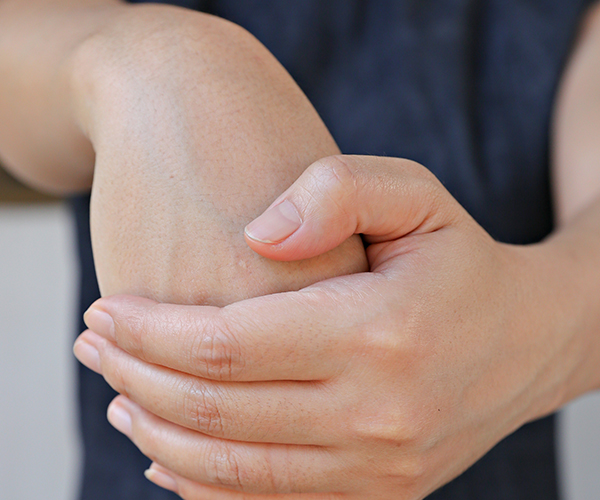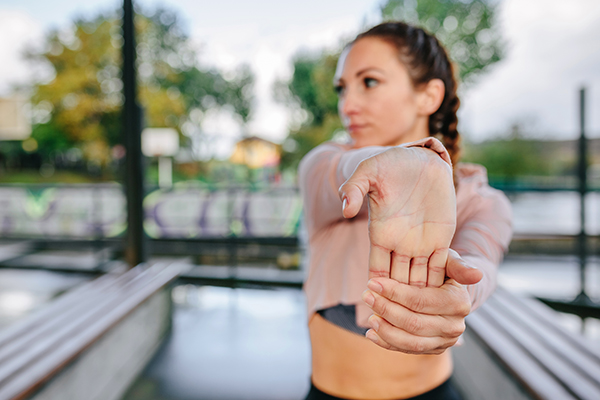6 Easy Stretches to Help Relieve Wrist Pain

The last time you checked, the plank was supposed to be a core exercise, and push-ups were meant to challenge your chest, arm, and shoulder strength.
So why do you primarily feel these types of movements in your wrists?
What’s the cause behind your exercise-induced wrist pain, and can wrist stretches help?
Why Do My Wrists Hurt?

The reasons behind wrist pain vary, explains Sara Mikulsky, PT, DPT, FNS, CEAS, owner of Wellness Physical Therapy in New York City.
“It can be related to the joint or bone, muscle or tendon, and occasionally the nerve,” she says.
For example:
- If you feel pain on the backside of your wrist when doing a push-up or plank, you may have limited joint mobility due to stiffness in the bone segment.
- Discomfort on the palm side can indicate a tight tendon or forearm muscle, while burning or tingling could point to nerve compression.
While some cases of wrist pain should be assessed by a medical professional (see below), wrist stretches and mobility exercises can often help alleviate wrist discomfort experienced while exercising or after a long day at your keyboard.
Below is a list of wrist stretches, exercises, and mobility drills that you can do pretty much any time.
However, Brian Cardin, PT, C.PED, owner of Cardin & Miller Physical Therapy in Carlisle, Pennsylvania, strongly recommends doing wrist stretches before a strength-training workout.
“To address some common underlying mobility restrictions, it would be safe and wise for people to do some mobility and stretching activity prior to working into loaded exercise,” he says.
1. Wrist Extensor Stretch

- Stand with your feet shoulder-width apart and, with your elbow extended, lift your right arm so that it’s parallel to the floor.
- Flex your wrist so that your palm and fingers are facing downward. Use your left hand to gently press down on the back of the hand to deepen the stretch.
- Hold for 30 seconds before switching sides.
2. Wrist Flexor Stretch
- Stand with your feet shoulder-width apart and, with your elbow extended, lift your right arm so that it’s parallel to the floor.
- Extend your wrist so that your fingertips are facing upward. Use your left hand to gently pull the fingers back to deepen the stretch.
- Hold for 30 seconds before switching sides.
3. Prayer Stretch
- Stand with your feet shoulder-width apart and press the palms of your hands together in a “prayer-like” position with your fingertips facing upward.
- Keeping your palms together, lower your hands until you feel a stretch in the wrists. (If you feel any pain or tingling, you’ve gone too far.)
- Hold for 30 seconds.
4. Wrist Circles
- Stand with your feet shoulder-width apart. With your elbows extended, lift both arms so that they’re parallel to the floor. Make two loose fists with your hands.
- Moving in a clockwise direction, rotate your wrists to make small circles with your fists.
- Continue for 30 seconds before switching directions.
5. Forearm Self-Myofascial Release
- Sit or kneel in front of a bench or other flat, elevated surface. Place a tennis ball on the bench and position the back of your right forearm on top of it.
- Use your left hand to gently press your right forearm into the ball and roll the length of your forearm over the ball. Linger on any spots that feel tight or tender.
- Roll for 30-60 seconds, and then flip your arm to roll out the inner forearm.
- Roll for 30-60 seconds before switching arms.
6. Banded Row
Note: The banded row is actually a back and shoulder complex strengthening exercise, not a stretch or mobility drill.
“If the shoulder blade is weak, we can overuse the wrist, causing the structures to work past the limit,” explains Mikulsky. “By keeping the shoulder blades strong, we can prevent overuse injuries.”
- Anchor the middle of a resistance band to a fixed, sturdy, chest-level object like a pole or lifting rig.
- Stand tall with your feet shoulder-width apart and hold each end of the resistance band in your hands, palms facing in.
- Lift your arms so that they’re parallel to the floor, keep your arms fully extended, and step back until you feel resistance on the band. This is the starting position.
- Keeping your back flat and core engaged, bend your elbows and draw your hands back toward your ribs in a rowing motion. Hold, and then slowly return to the starting position.
When to See a Doctor About Wrist Pain

In some cases, wrist pain should be evaluated by a medical professional. If you experience any of the following, see your doctor.
Wrist pain after a fall
Don’t ignore wrist pain that occurs after a fall, as it could result from a stress fracture of the radial bone.
“This occurs more commonly with a history of osteoporosis, but it can occur in normal bone,” Mikulsky says.
“If the pain is constant in the wrist and does not change with motion, seeking imaging to rule out a fracture may be necessary,” she adds.
Burning or tingling
Is your wrist pain accompanied by a burning or tingling sensation in the wrists or hands? You’ll want to rule out carpal tunnel syndrome (CTS). “If this syndrome is not treated, it can lead to permanent damage to the nerve and severe weakness of the hand muscles,” Mikulsky says.
Wrist pain with upper arm and neck pain
If you’re experiencing pain in your wrist and upper arm, and neck, the issue may not be wrist-related.
“This type of pain is common with a ‘pinched nerve’ or herniated disc in the neck and is treated differently than an injury of the wrist,” Mikulsky says.
Persistent pain
If your wrist pain persists despite consistent stretching and mobility work, Cardin recommends seeing a physical therapist.
“In some cases, there may be joint capsule restrictions that the therapist can help to resolve or structural issues that may need to be worked around to allow for safe and comfortable exercise.”
